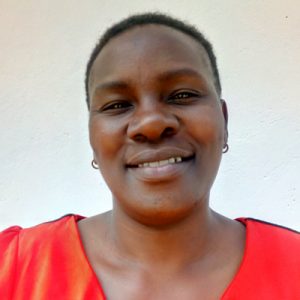Please note: original photos were taken before the COVID-19 pandemic.
The people of Eshiakhulo B Community have suffered a great deal for a long time due to a lack of clean water. 200 community members rely on Temesi Spring for all of their daily water needs, and yet it is not safe for consumption. People here are frequent visitors to the health centers where they are diagnosed with typhoid, amoeba, and diarrhea, especially among children.
We connected with the community using Temesi Spring through Peter Temesi, the spring's landowner. Peter had visited Kweyu Spring, which we recently protected, and requested an intervention at Temesi Spring. After confirming the spring's eligibility for protection using our rigorous pre-assessment, Peter confirmed that his community had already mobilized the locally available materials needed for construction. They were ready to help themselves get clean, safe water.
Temesi Spring sits open to contamination from the environment, animals, and people. Community members report encountering insects and frogs in the water - sometimes even some dead ones - while the living ones will jump into their containers as they try to fetch water. The terrain leading to the spring gets slippery with mud when it rains, sometimes causing falls, spilled water, and injuries.
"The water is dirty, muddy, and the rough terrain causes us to fall down when fetching water. It's a very bad experience for me. I always accompany my siblings to fetch water because I fear that they will fall down," reported teenager Evans.
The makeshift discharge pipe the community put directly into the earth inevitably allows some water to escape around the pipe's edges, so it takes a while to fetch water. Hence, there is often overcrowding at the spring while people wait their turn. In an effort to save time, some people will cut the line and try to fetch water from above the pipe, dirtying the water in the pipe for the next person until the sand and dirt settles once again.
The crowds are worst in the mornings, when most people need to fetch water to start their day. This is especially troubling during the pandemic, exactly when people are trying to avoid crowds and limit their time in public. Disagreements and conflict between families are common due to heightened frustrations at the spring.
"Time wasted in fetching water - especially in the morning - affects me. Some people prefer to fetch the water from the backfilling, hence making the water coming through the pipe dirty. So we have to stop and wait for them to finish, then allow it to settle before we can fetch again," said 32-year-old Cecilia Martin.
The people of Eshiakhulo B Community are farmers. They farm maize, beans, and sugarcane, along with local vegetables. They are also fish farmers, breeding fish in ponds fed by water from Temesi Spring. Some people farm for others to earn their income, while others are employed as teachers and health workers. There are small-scale businesses, and boda boda riders (motorcycle taxis) too. The entire community is hard-working, but they need clean water to be able to focus on their good health, work, and school.
What We Can Do:
Spring Protection
Protecting the spring will help provide access to cleaner and safer water and reduce the time people have to spend to fetch it. Construction will keep surface runoff and other contaminants out of the water. With the community’s high involvement in the process, there should be a good sense of responsibility and ownership for the new clean water source.
Fetching water is a task predominantly carried out by women and young girls. Protecting the spring and offering training and support will, therefore, help empower the female members of the community by freeing up more of their time and energy to engage and invest in income-generating activities and their education.
Training on Health, Hygiene, COVID-19, and More
To hold trainings during the pandemic, we work closely with both community leaders and the local government to approve small groups to attend training. We ask community leaders to invite a select yet representative group of people to attend training who will then act as ambassadors to the rest of the community to share what they learn. We also communicate our expectations of physical distancing and wearing masks for all who choose to attend.
The training will focus on improved hygiene, health, and sanitation habits in this community. We will also have a dedicated session on COVID-19 symptoms, transmission routes, and prevention best practices.
With the community’s input, we will identify key leverage points where they can alter their practices at the personal, household, and community levels to affect change. This training will help to ensure participants have the knowledge they need about healthy practices and their importance to make the most of their water point as soon as water is flowing.
Our team of facilitators will use a variety of methods to train community members. Some of these methods include participatory hygiene and sanitation transformation, asset-based community development, group discussions, handouts, and demonstrations at the spring.
One of the most important issues we plan to cover is the handling, storage, and treatment of water. Having a clean water source will be extremely helpful, but it is useless if water gets contaminated by the time it is consumed. We and the community strongly believe that all of these components will work together to improve living standards here, which will help to unlock the potential for these community members to live better, healthier lives.
We will then conduct a small series of follow-up trainings before transitioning to our regularly scheduled support visits throughout the year.
Training will result in the formation of a water user committee, elected by their peers, that will oversee the operations and maintenance of the spring. The committee will enforce proper behavior around the spring and delegate tasks that will help preserve the site, such as building a fence and digging proper drainage channels. The fence will keep out destructive animals and unwanted waste, and the drainage will keep the area’s mosquito population at a minimum.
Sanitation Platforms
At the end of training, participants will select 5 families that should benefit from new concrete latrine floors called sanitation platforms. Training will inform the community and selected families on what they need to contribute to make this project a success. They must mobilize locally available materials, including bricks, clean sand, and gravel. The 5 families chosen for sanitation platforms must prepare by sinking a pit for the sanitation platforms to be placed over.
All community members must work together to make sure that accommodations and food are always provided for the work teams. The families will then be asked to complete their latrines by constructing a superstructure over their platforms. These 5 sanitation platforms will then serve as examples for the rest of the community to replicate.

 Protected Spring
Protected Spring
 Rehabilitation Project
Rehabilitation Project




















































